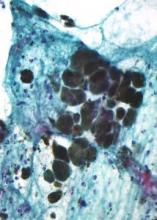That might happen any day now. Reuters said on August 9 that the FDA's approval of vemurafenib could be announced soon. Roche/Genentech submitted their NDA for vemurafenib to the FDA in May, and in June came impressive efficacy results in a phase 3 study that was reported at both ASCO and in a NEJM article.
Last week, I covered the American Academy of Dermatology's Summer Academy meeting in New York, where melanoma specialist Richard D. Carvajal from Memorial Sloan-Kettering said that once vemurafenib was on the market genetic analysis of advanced melanomas to find BRAF mutations would suddenly become standard of care. Once testing for one mutation starts, several more genes can easily piggyback onto the assay, which will help to further flesh out the range of genetic mutations that can exist in metastatic melanoma and provide potential targets for new drugs.
It's becoming a well-trodden path that's rapidly driving the treatment of advanced cancers of all kinds into the molecular-profiling era.
Just a couple of weeks ago, I blogged about how it had already transformed advanced lung cancer management. Breast cancer and colorectal cancer have an even longer history of genetic assessment, and more cancers will likely follow this route soon.
When I wrote my blog post about lung cancer in late July, I focused on the challenge to successfully treating late-stage cancer, and I said that better alternatives were lung cancer prevention, by not smoking, and earlier diagnosis, with CT screening.
Melanoma does not pose the same screening issues as lung cancer. It's a lot easier to survey the skin than to peer into a person's lungs. And the idea of melanoma prevention by sunlight avoidance and protection has transformed the way many Americans approach outdoor activity. Over the last generation or so, SPF has become a cultural touchstone.
Despite that, cases of advanced melanoma are inevitable.
At the AAD meeting, Darrell S. Rigel from New York University showed evidence of a troubling, new wrinkle in melanoma epidemiology: An appreciable blip in cases that first appeared about 10 years ago in American women aged 30-34, a shift that Dr. Rigel attributed to an increased use of tanning salons among teenage girls that started in the 1980s.
Even if advanced stage tumors, melanoma or lung cancers, are unstable and unlikely to respond to even the best targeted of drugs for more than a few years, those extra years of cancer control with good quality of life can make a big difference to each patient who responds to a genetically-targeted treatment, Dr. Carvajal told me.
—Mitchel Zoler (on Twitter @mitchelzoler)


